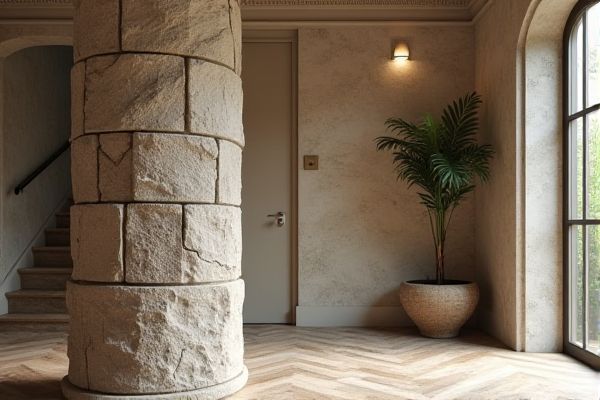
Faux stone columns offer a lightweight, cost-effective alternative to real stone columns, providing ease of installation and versatility in design without compromising on aesthetic appeal. Discover the key differences that can help you decide which option best suits Your architectural needs by reading the rest of this article.
Table of Comparison
| Feature | Faux Stone Column | Real Stone Column |
|---|---|---|
| Material | Polyurethane, fiberglass, or composite materials | Granite, marble, limestone, or natural stone |
| Weight | Lightweight, easy to handle | Heavy and bulky |
| Installation | Quick and simple, less labor intensive | Requires skilled labor and heavy equipment |
| Cost | Affordable, budget-friendly | Expensive, high material and labor costs |
| Durability | Moderate, may fade or chip over time | Highly durable, withstands weathering |
| Maintenance | Low maintenance, occasional cleaning | Requires sealing and regular upkeep |
| Appearance | Imitates stone texture and color, less authentic | Natural, unique stone patterns |
| Lifespan | 10-20 years depending on environment | 50+ years with proper care |
Introduction: Faux Stone Columns vs. Real Stone Columns
Faux stone columns offer a lightweight, cost-effective alternative to real stone columns while mimicking the appearance of natural stone. Real stone columns provide unmatched durability, natural texture, and variations unique to materials like granite, marble, or limestone. Choosing between faux and real stone columns depends on factors such as budget, structural support, and desired aesthetic authenticity.
Material Composition and Manufacturing Process
Faux stone columns are typically made from lightweight materials such as fiberglass, polyurethane, or cast resin, designed to replicate the look of real stone while being easier to install and more cost-effective. Real stone columns consist of natural materials like granite, limestone, or marble, quarried and carved, offering superior durability and authentic texture but requiring more labor-intensive manufacturing and higher costs. Your choice depends on whether you prioritize the authentic feel and longevity of real stone or the versatility and affordability of faux stone columns.
Visual Appearance and Authenticity
Faux stone columns offer a wide range of colors and textures that can closely mimic the look of real stone, but they often lack the natural variation and depth found in authentic stone materials. Real stone columns provide unmatched authenticity with unique patterns, weathering effects, and a tactile surface that enhances architectural elegance. Visual appearance of real stone is characterized by natural imperfections and mineral grain, which faux stone materials strive to replicate but seldom achieve fully.
Structural Strength and Durability
Real stone columns offer superior structural strength and long-term durability due to their natural density and resistance to weathering, making them ideal for supporting heavy loads in construction. Faux stone columns, while visually appealing and lightweight, lack the inherent strength of real stone and are more susceptible to damage from impact and environmental factors. Your choice should consider the necessity for load-bearing capacity and maintenance requirements to ensure optimal performance and longevity.
Installation Process and Time
Faux stone columns offer a faster installation process, typically completed within a few hours due to lightweight materials and pre-formed sections that easily attach to existing structures. Real stone columns require extensive time for cutting, shaping, and mortaring heavy stone blocks, often taking days or weeks depending on column size and craftsmanship. The reduced labor and material handling make faux stone columns a more time-efficient choice for remodeling or new construction projects.
Cost Comparison: Faux vs. Real Stone Columns
Faux stone columns generally cost significantly less than real stone columns, with prices typically ranging from $50 to $150 per linear foot compared to $200 to $400 for natural stone. Installation expenses also favor faux stone due to its lighter weight and easier handling, reducing labor time and overall project cost. Real stone columns offer unmatched durability and a natural aesthetic but require higher upfront investment and more complex structural support.
Maintenance and Long-Term Care
Faux stone columns require minimal maintenance, as they resist cracking, chipping, and erosion, making them ideal for long-term durability with periodic cleaning and occasional touch-ups. Real stone columns demand more intensive upkeep, including sealing to prevent water infiltration, repairs for cracks or chips, and potential professional restoration to maintain structural integrity over time. Choosing faux stone significantly reduces long-term care costs and efforts while preserving aesthetic appeal.
Weight and Load-Bearing Capacity
Faux stone columns are significantly lighter than real stone columns, making them easier to install and reducing structural load on your building. Real stone columns offer superior load-bearing capacity, providing durable support for heavy architectural elements. Choosing between the two depends on whether your project prioritizes ease of installation or maximum structural strength.
Design Versatility and Customization Options
Faux stone columns offer greater design versatility and customization options compared to real stone columns, as they can be molded into various shapes, colors, and textures to match diverse architectural styles. These lightweight alternatives allow for easier installation and modifications, enabling designers to create intricate patterns and unique finishes that real stone cannot easily achieve. Real stone columns provide natural variation and durability but are limited by the inherent properties of the quarried material, often restricting customization to size and surface treatment.
Environmental Impact and Sustainability
Faux stone columns offer a significantly lower environmental impact compared to real stone columns due to reduced quarrying and extraction processes, which help conserve natural resources and minimize habitat disruption. Manufactured from lightweight synthetic materials such as fiberglass or polyurethane, faux stone columns require less energy for production, transportation, and installation, enhancing their sustainability profile. Real stone columns, while durable and natural, contribute to higher carbon emissions and landscape degradation, making faux stone a more eco-friendly choice for sustainable building projects.
 homyna.com
homyna.com